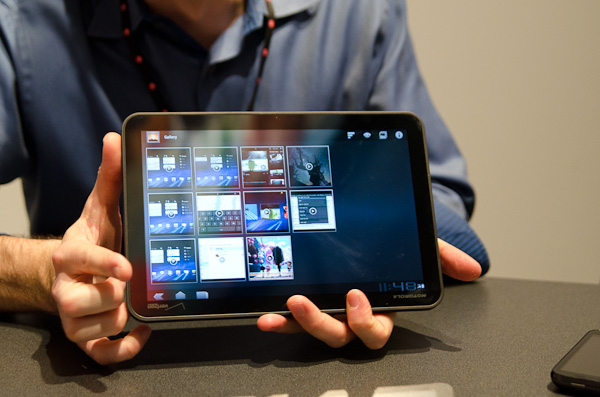CES 2011: Motorola Xoom & NVIDIA Tegra 2: The Honeycomb Platform
by Anand Lal Shimpi on January 10, 2011 2:27 PM ESTThe two biggest announcements at CES 2011? Intel’s Sandy Bridge and pretty much everything NVIDIA talked about at its press conference (as well as the MS Windows 8/ARM announcement which I’ll discuss later).
NVIDIA finally got to talk about Project Denver as well as show off its first Tegra 2 based smartphones. The LG Optimus 2X, Motorola Atrix 4G and Droid Bionic will all be shipping in the next 2 months and all of them use NVIDIA’s Tegra 2 SoC.
The Android tablet market is another focus for Tegra 2. A little known fact is that Tegra 2 is the reference SoC for Honeycomb, the official Android release for tablets. Being selected by Google is another huge boon for NVIDIA’s Tegra business, although from the looks of it we’ll still see more Qualcomm based Honeycomb tablets than Tegra 2 solutions by the end of the year.
I played with the Xoom a bit in my Motorola meeting. Unfortunately Google won’t allow Honeycomb to be demoed, so Motorola was just running a looped video on the Xoom. Build quality felt good despite being handled tons at the show. The Xoom is very iPad like in its size and functionality. The major physical change is the power/lock button is on the back of the device vs. the top.
The full specs of the Xoom are below:
| Motorola XOOM Tablet | ||||||
| OS | Android 3.0 Honeycomb | |||||
| Differentiation | Larger display in smaller form-factor, 1080p HD support, first tablet with Honeycomb software, dual-core 1GHz processor, and a wide range of docking options | |||||
| Dimensions | 249.1mm (h) x 167.8mm (w) x 12.9mm (d) | |||||
| Display | 10.1” 1280x800 | |||||
| Weight | 730 g | |||||
| Processor | NVIDIA® Tegra™ 2: 1GHz dual-core processor | |||||
| Battery | Up to 10 hour video playback | |||||
| Connectivity | 3.5mm, micro USB 2.0 HS, Corporate Sync, Wi-Fi 2.4GHz & 5GHz 802.11b/g/n, Bluetooth 2.1 + EDR + HID | |||||
| Network | EvDO Rev.A - Verizon 800/1900 | |||||
| Messaging/Web/Apps | Email (Corporate Sync, Google Mail, POP3/IMAP embedded, Push Email, Yahoo Mail) , WebKit w/ Flash | |||||
| Audio | AAC, AAC+, AMR NB, AMR WB, MP3, XMF | |||||
| Video | 720p capture/1080p playback/streaming, H.263, H.264, MPEG4 | |||||
| Camera | 5 MP rear-facing camera with dual LED flash/2MP front-facing camera | |||||
| Memory | 32GB on board user memory, SD card support after software update, 1GB DDR2 RAM | |||||
One interesting feature is the Xoom will be upgradeable to support LTE. The PCB doesn’t have any LTE modem on it however Motorola is hinting at some sort of carrier/OEM upgrade process. Presumably you’d ship your Xoom out to either the carrier or directly to Motorola and they’d mount an LTE modem, give you an LTE SIM and you’d be on your way. The Xoom already ships with the required SIM tray, the modem is the only change you'll have to make to enable LTE.

















8 Comments
View All Comments
solipsism - Monday, January 10, 2011 - link
Any estimates given?Rayb - Monday, January 10, 2011 - link
First half of the year and according to other people, it would cost around $650-850 without a contract.Or if you want to pre-order...
http://androidcommunity.com/motorola-xoom-tablet-a...
GotThumbs - Monday, January 10, 2011 - link
Tablets will definitely be a hot topic for this coming year. I Read an interesting article comparing XOOM with little known ADAM. Any chance Anand could get a hold of an ADAM for a comparison?http://androidos.in/2011/01/notion-ink-adam-vs-mot...
vol7ron - Monday, January 10, 2011 - link
"32GB on board user memory"Does referring to long-term storage as memory bother anyone?
MISRy - Tuesday, January 11, 2011 - link
Technically, couldn't an SSD or even a flash drive be referred as memory?daveloft - Monday, January 17, 2011 - link
Tecnically? No.Memory is RAM. Flash, SSD and Hard Disc storage is ROM. Referring to storage as memory is just plain wrong.
KillaKilla - Monday, January 24, 2011 - link
If your HDD or SSD is operating in ROM you either have ridiculous security, or something is very, very broken. ROM stands for Read Only Memory, and is still memory. Really, almost anything can be used as RAM, and there are many different tiers. You're probably referring to one specific tier of memory, that's used as a volatile short-term storage. Usually on this kind of device less than or equal to 1GB.TareX - Monday, January 24, 2011 - link
I guess the worst thing about being completely buttonless is that it will take an extra touch to do almost anything.